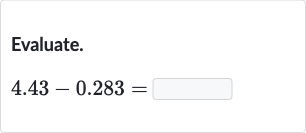AI tutor
Full solution
Q. Evaluate.
- Align decimal points: To subtract two decimal numbers, align the decimal points and subtract the numbers as if they were whole numbers, borrowing if necessary.Calculation: We need to align the decimal points and make sure each place has a digit, so we can write as to match the number of decimal places in . \begin{align*} &4.43 \ -&0.283 \end{align*} Now we subtract the numbers column by column, starting from the rightmost digit.
- Subtract thousandths place: Subtract the thousandths place (rightmost column): . We cannot subtract from without borrowing, so we borrow from the hundredths place.The hundredths place in becomes , and we add to the thousandths place, making it .Now we have in the thousandths place.
- Subtract hundredths place: Subtract the hundredths place: (after borrowing) . Again, we cannot subtract from without borrowing, so we borrow from the tenths place.The tenths place in becomes , and we add to the hundredths place, making it .Now we have in the hundredths place.
- Subtract tenths place: Subtract the tenths place: (after borrowing) = in the tenths place.
- Subtract ones place: Subtract the ones place: in the ones place.
- Combine the results: Combine the results to get the final answer. in the ones place, in the tenths place, in the hundredths place, and in the thousandths place gives us .
More problems from Solve one-step addition and subtraction equations with decimals and fractions
QuestionGet tutor help

